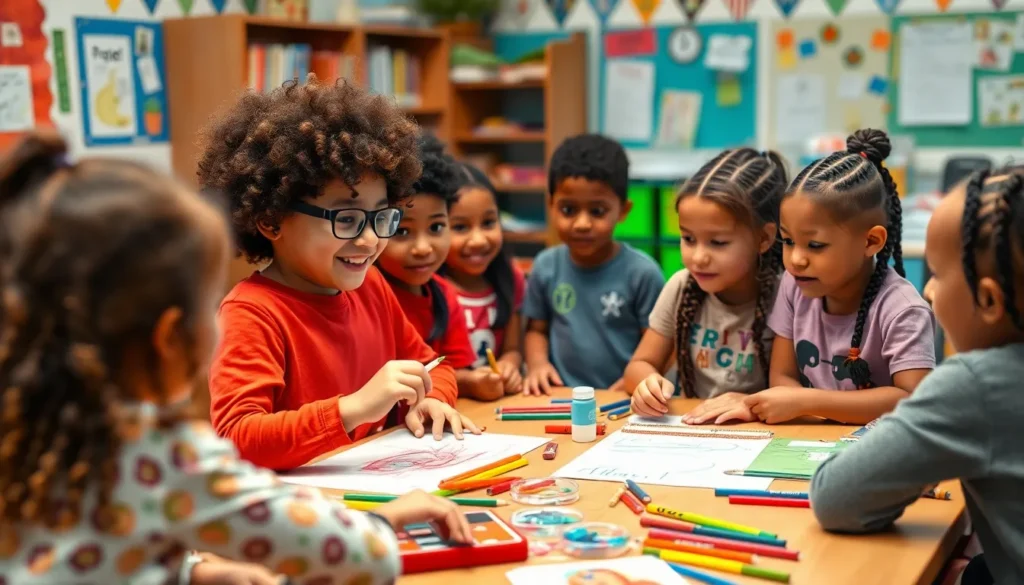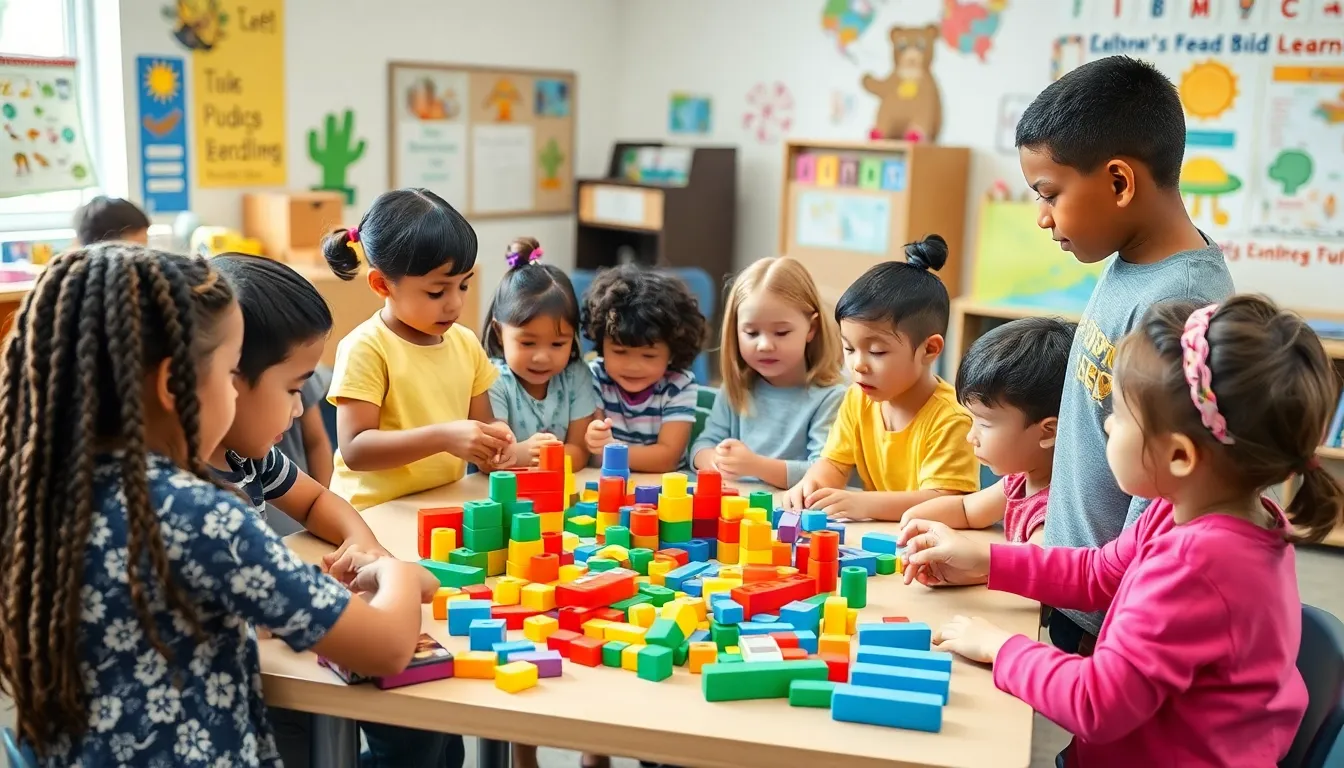Table of Contents
ToggleIn a world where one-size-fits-all education often leaves kids feeling like square pegs in round holes, child-centered learning emerges as the superhero of modern education. Picture a classroom where kids are the captains of their own ships, navigating the seas of knowledge with curiosity as their compass. It’s not just about hitting the books; it’s about igniting a passion for learning that lasts a lifetime.
Understanding Child-Centered Learning
Child-centered learning prioritizes the needs, interests, and abilities of children in the educational process. This approach encourages active engagement, fostering a love for learning through exploration and collaboration.
Definition and Key Concepts
Child-centered learning emphasizes the role of the student in their own educational journey. It allows students to pursue their interests while guiding them in developing critical thinking and problem-solving skills. Active participation and formal instruction coexist, promoting exploration and collaboration. Teachers act as facilitators, supporting diverse learning styles and ensuring educational environments are inclusive and adaptable. Personal growth aligns with academic achievement, driving lifelong learning habits.
Historical Background
The roots of child-centered learning trace back to progressive educational theorists like John Dewey and Maria Montessori. Dewey championed experiential learning, believing that education should reflect children’s experiences. Montessori approached education through self-directed activities, emphasizing independence and hands-on learning. These philosophies gained traction in the 20th century, influencing contemporary educational practices. Today, child-centered learning continues to evolve, responding to shifts in societal values and advances in educational research. This ongoing adaptation ensures the approach remains relevant in diverse learning environments.
Principles of Child-Centered Learning
Child-centered learning emphasizes engaging students in their education process. This approach includes key principles that enhance the learning experience.
Active Learning
Active learning focuses on students participating directly in their learning. This principle empowers children to explore their interests, ask questions, and engage in hands-on activities. Examples include experiments, problem-solving tasks, and discussions that encourage critical thinking. This environment fosters curiosity and deeper understanding. Teachers facilitate by providing resources and guidance, allowing children to take ownership of their learning.
Collaborative Environment
A collaborative environment encourages teamwork and communication among students. Children learn effectively when they work together on projects and share ideas. Group activities enhance social skills and build a sense of community. Teachers play a crucial role by setting up diverse group dynamics and promoting inclusivity. When children collaborate, they learn to respect differing perspectives, preparing them for future teamwork scenarios. This principle fosters essential life skills that extend beyond the classroom.
Benefits of Child-Centered Learning
Child-centered learning offers several important advantages that enhance the educational experience. This approach prioritizes student engagement and critical thinking, ultimately fostering a more enriching environment for children.
Enhanced Engagement
Active participation captures children’s attention and motivates them to explore subjects more deeply. Students involved in their own learning often demonstrate heightened enthusiasm and involvement. They discover personal interests while collaborating with peers, leading to stronger connections with the material. This immersion results in a more meaningful educational experience. Additionally, teachers facilitate opportunities for exploration, ensuring students remain curious and eager to learn.
Improved Critical Thinking Skills
Child-centered learning develops critical thinking skills essential for problem-solving. As students encounter real-world challenges, they analyze information, make decisions, and evaluate outcomes. Engaging in discussions and collaborative projects strengthens analytical abilities. Teachers guide this process, encouraging students to ask questions and think independently. Students also learn to approach problems creatively, gaining confidence in their ability to devise solutions. Ultimately, these skills equip learners for future academic and professional success.
Implementing Child-Centered Learning in the Classroom
Implementing child-centered learning shifts the focus from traditional methods to a more engaging educational experience. This process encourages active participation and a personalized approach.
Strategies for Teachers
Encouraging exploration forms the basis of effective strategies. Teachers facilitate hands-on activities that spark curiosity. Each lesson incorporates student interests, promoting deeper learning. Collaboration amongst students enhances teamwork skills and fosters a community atmosphere in the classroom. Utilizing varied assessment methods tracks student progress while adapting lessons to meet diverse learning styles. Educators support a safe environment where mistakes are viewed as valuable learning opportunities.
Role of Parents and Community
Parents play an integral role in child-centered learning initiatives. Engaging families strengthens the connection between home and school, enhancing student support. Community involvement provides additional resources, enriching learning experiences outside the classroom. Workshops and events allow parents to participate actively and understand educational approaches. Local organizations can offer guest speakers and unique opportunities that relate to students’ interests, deepening their engagement and connection to real-world applications.
Challenges of Child-Centered Learning
Child-centered learning presents unique challenges that educators must navigate for successful implementation. Understanding these challenges is crucial for enhancing educational experiences.
Common Misconceptions
Misunderstandings about child-centered learning often arise. Some believe this approach lacks structure, equating it with chaos. Others think it diminishes the teacher’s role. In reality, educators facilitate rather than control the learning environment. Parents may also worry that their children won’t acquire essential knowledge or skills. Clear communication about the goals and benefits of child-centered methodologies can help dispel these myths, fostering a supportive learning atmosphere.
Resource and Training Limitations
Insufficient resources pose significant hurdles for schools adopting child-centered learning. Limited access to instructional materials can hinder hands-on activities that engage students. Training for teachers often falls short, with many lacking comprehensive professional development on this approach. Without proper training, educators may struggle to balance facilitation with curriculum requirements. Schools can address these limitations by seeking external funding and focusing on consistent training programs, thus ensuring that teachers are equipped to implement effective child-centered strategies.
Conclusion
Child-centered learning stands as a powerful alternative to traditional educational methods. By prioritizing the unique needs and interests of each child it fosters a more engaging and meaningful learning experience. This approach not only enhances critical thinking and problem-solving skills but also nurtures a love for learning that extends beyond the classroom.
As educators and communities embrace this transformative framework they create environments where children can thrive. The collaboration between teachers, parents, and local organizations enriches learning opportunities and builds a strong support system for students. Overcoming challenges in implementation will pave the way for a more inclusive and effective educational landscape. Embracing child-centered learning is essential for preparing future generations for success in an ever-evolving world.








